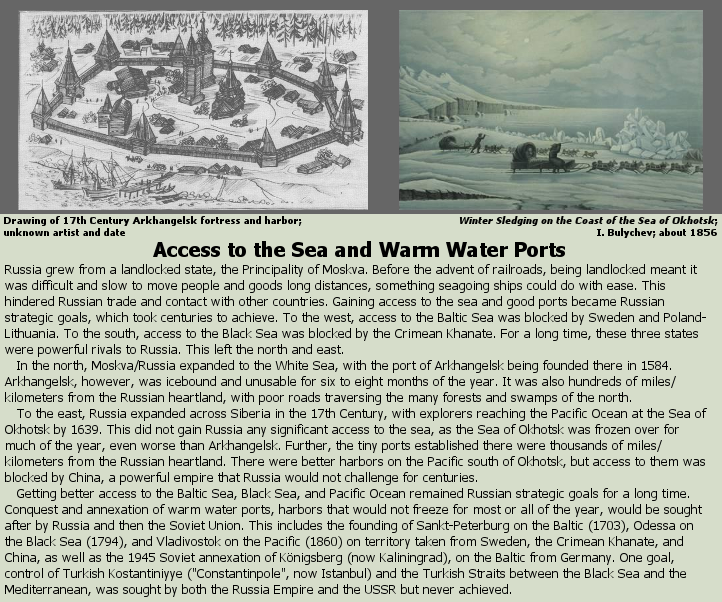

Access to the Sea and Warm Water Ports
Russia grew from a landlocked state, the Principality of Moskva. Before the advent of railroads, being landlocked meant it was difficult and slow to move people and goods long distances, something seagoing ships could do with ease. This hindered Russian trade and contact with other countries. Gaining access to the sea and good ports became Russian strategic goals, which took centuries to achieve. To the west, access to the Baltic Sea was blocked by Sweden and Poland-Lithuania. To the south, access to the Black Sea was blocked by the Crimean Khanate. For a long time, these three states were powerful rivals to Russia. This left the north and east.
In the north, Moskva/Russia expanded to the White Sea, with the port of Arkhangelsk being founded there in 1584. Arkhangelsk, however, was icebound and unusable for six to eight months of the year. It was also hundreds of miles/kilometers from the Russian heartland, with poor roads traversing the many forests and swamps of the north.
To the east, Russia expanded across Siberia in the 17th Century, with explorers reaching the Pacific Ocean at the Sea of Okhotsk by 1639. This did not gain Russia any significant access to the sea, as the Sea of Okhotsk was frozen over for much of the year, even worse than Arkhangelsk. Further, the tiny ports established there were thousands of miles/kilometers from the Russian heartland. There were better harbors on the Pacific south of Okhotsk, but access to them was blocked by China, a powerful empire that Russia would not challenge for centuries.
Getting better access to the Baltic Sea, Black Sea, and Pacific Ocean remained Russian strategic goals for a long time. Conquest and annexation of warm water ports, harbors that would not freeze for most or all of the year, would be sought after by Russia and then the Soviet Union. This includes the founding of Sankt-Peterburg on the Baltic (1703), Odessa on the Black Sea (1794), and Vladivostok on the Pacific (1860) on territory taken from Sweden, the Crimean Khanate, and China, as well as the 1945 Soviet annexation of Königsberg (now Kaliningrad), on the Baltic from Germany. One goal, control of Turkish Kostantiniyye ("Constantinpole", now Istanbul) and the Turkish Straits between the Black Sea and the Mediterranean, was sought by both the Russia Empire and the USSR but never achieved.